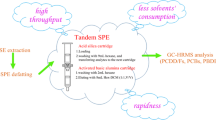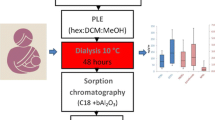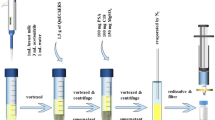Abstract
The widespread use of perfluoroalkyl substances has resulted in the universal exposure of humans to these endocrine-disrupting chemicals, including the exposure of neonates through breastfeeding. The objective of this study was to develop a method to determine 10 perfluoroalkyl substances in breast milk (1-mL aliquot) by combining salt-assisted liquid-liquid extraction with dispersive liquid-liquid microextraction and using high-performance liquid chromatography-tandem mass spectrometry. Chemometric strategies were applied to optimize experimental parameters. The limit of quantification was 20 pg mL−1 for all analytes, and inter-day variability (evaluated as relative standard deviation) ranged from 8.2 to 13.8%. The method was validated by a recovery assay with spiked samples. Percentage recoveries ranged from 85.9 to 110.8%. The method was satisfactorily applied to assess target compounds in 20 breast milk samples from donors. Perfluorooctanoic acid, perfluorooctane sulfonate, and perfluorohexanoic acid were the most frequently detected analytes. This analytical procedure can provide useful information on newborn’s exposure to these xenobiotics.




Similar content being viewed by others
References
Prevedouros K, Cousins IT, Buck RC, Korzeniowski SH. Sources, fate and transport of perfluorocarboxylates. Environ Sci Technol. 2005;40:32–4.
OECD – Organisation for Economic Co-operation and Development. Risk reduction approaches for PFASs – a cross country analysis. Series on Risk Management. Environment Directorate. 2015;29 Accessible from: https://www.oecd.org/chemicalsafety/risk-management/Risk_Reduction_Approaches%20for%20PFASS.pdf. Accessed 9 May 2020.
Yeung LW, Robinson SJ, Koschorreck J, Mabury SA. PartII. A temporal study of PFOS and its precursors in human plasma from two German cities in 1982-2009. Environ Sci Technol. 2013;47:3875–82.
Toms LM, Thompson J, Rotander A, Hobson P, Calafat AM, Kato K, et al. Decline in perfluorooctane sulfonate and perfluorooctanoate serum concentrations in an Australian population from 2002 to 2011. Environ Int. 2014;71:74–80.
Okada E, Kashino I, Matsuura H, Sasaki S, Miyashita C, Yamamoto J, et al. Temporal trends of perfluoroalkyl acids in plasma samples of pregnant women in Hokkaido, Japan, 2003-2011. Environ Int. 2013;60:89–96.
Zhang T, Sun H, Qin X, Gan Z, Kannan K. PFOS and PFOA in paired urine and blood from general adults and pregnant women: assessment of urinary elimination. Environ Sci Pollut Res. 2015;22:5572–9.
Preston EV, Webster TF, Oken E, Claus Henn B, McClean MD, Rifas-Shiman SL, et al. Maternal plasma per- and polyfluoroalkyl substance concentrations in early pregnancy and maternal and neonatal thyroid function in a prospective birth cohort: Project Viva (USA). Environ Health Perspect. 2018;126(2):027013.
Stockholm Convention, United Nations Environment Program’s Stockholm Convention on Persistent Organic Pollutants, 2009. Accessible from: http://chm.pops.int/TheConvention/ThePOPs/ListingofPOPs/tabid/2509/Default.aspx. Accessed 9 May 2020.
US EPA, United States Environmental Protection Agency, 2010/2015 PFOA Stewardship Program, 2006. Accessible from: https://www.epa.gov/assessingand-managing-chemicals-under-tsca/20102015-pfoa-stewardship-program. Accessed 10 May 2020.
Commission Regulation (EU) 2017/1000 of 13 June 2017 amending Annex XVII to Regulation (EC) No 1907/2006 of the European Parliament and of the Council concerning the Registration, Evaluation, Authorisation and Restriction of Chemicals (REACH) as regards perfluorooctanoic acid (PFOA), its salts and PFOA-related substances (Text with EEA relevance.). Accessible from: https://op.europa.eu/en/publication-detail/-/publication/d14f70da-508b-11e7-a5ca-01aa75ed71a1/language-en. Accessed 15 May 2020.
US EPA, EPA actions to address PFAS, Accessible from https://www.epa.gov/pfas/epa-actions-address-pfas. Accessed 15 May 2020.
Fei CY, McLaughlin JK, Lipworth L, Olsen J. Maternal levels of perfluorinated chemicals and subfecundity. Hum Reprod. 2009;24:1200–5.
Frisbee SJ, Shankar A, Knox SS, Steenland K, Savitz DA, Fletcher T, et al. Perfluorooctanoic acid, perfluorooctanesulfonate, and serum lipids in children and adolescents. Arch Pediatr Adolesc Med. 2009;164(9):860–9.
Nelson JW, Hatch EE, Webster TF. Exposure to polyfluoroalkyl chemicals and cholesterol, body weight, and insulin resistance in the general US population. Environ Health Perspect. 2010;118(2):197–202.
Joensen UN, Veyrand B, Antignac JP, Jensen MB, Petersen JH, Marchand P, et al. PFOS (perfluorooctanesulfonate) in serum is negatively associated with testosterone levels, but not with semen quality, in healthy men. Hum Reprod. 2013;28(3):599–608.
Jensen AA, Leffers H. Emerging endocrine disrupters: perfluoroalkylated substances. Int J Androl. 2008;31(2):161–9.
White SS, Fenton SE, Hines EP. Endocrine disrupting properties of perfluorooctanoic acid. J Steroid Biochem Mol Biol. 2011;127(1–2):16–26.
World Health Organization (WHO). State of the Science of Endocrine Disrupting Chemicals-2012. Switzerland, 2013.
Barry V, Winquist A, Steenland K. Perfluorooctanoic acid (PFOA) exposures and incident cancers among adults living near a chemical plant. Environ Health Perspect. 2013;121(11–12):1313–8.
Johnson PI, Sutton P, Atchley DS, Koustas E, Lam J, Sen S, et al. The Navigation Guide - evidence-based medicine meets environmental health: systematic review of human evidence for PFOA effects on fetal growth. Environ Health Perspect. 2014;122:1028–39.
Kim S, Choi K, Ji K, Seo J, Kho Y, Park J, et al. Trans-placental transfer of thirteen perfluorinated compounds and relations with fetal thyroid hormones. Environ Sci Technol. 2011;45:7465–72.
Stein CR, Savitz DA. Serum perfluorinated compound concentration and attention deficit/hyperactivity disorder in children 5-18 years of age. Environ Health Perspect. 2011;119:1466–71.
Bloom MS, Kannan K, Spliethoff HM, Tao L, Aldous KM, Vena JE. Exploratory assessment of perfluorinated compounds and human thyroid function. Physiol Behav. 2010;99:240–5.
Freberg BI, Haug LS, Olsen R, Daae HL, Hersson M, Thomsen C, et al. Occupational exposure to airborne perfluorinated compounds during professional ski waxing. Environ Sci Technol. 2010;44:7723–8.
Takagi S, Adachi F, Miyano K, Koizumi Y, Tanaka H, Mimura M, et al. Perfluorooctanesulfonate and perfluorooctanoate in raw and treated tap water from Osaka, Japan. Chemosphere. 2008;72:1409–12.
Vestergren R, Orata F, Berger U, Cousins IT. Bioaccumulation of perfluoroalkyl acids in dairy cows in a naturally contaminated environment. Environ Sci Pollut Res Int. 2013;20:7959–69.
Falandysz J, Taniyasu S, Gulkowska A, Yamashita N, Schulte-Oehlmann U. Is fish a major source of fluorinated surfactants and repellents in humans living on the Baltic coast? Environ Sci Technol. 2006;40:748–51.
Tittlemier SA, Pepper K, Seymour C, Moisey J, Bronson R, Cao XL, et al. Dietary exposure of Canadians to perfluorinated carboxylates and perfluorooctane sulfonate via consumption of meat, fish, fast foods, and food items prepared in their packaging. J Agric Food Chem. 2007;55:3203–10.
Olsen GW, Burris JM, Ehresman DJ, Froehlich JW, Seacat AM, Butenhoff JL, et al. Half-life of serum elimination of perfluorooctane sulfonate, perfluoro hexanesulfonate and perfluorooctanoate in retired fluorochemical production workers. Environ Health Perspect. 2007;115(9):1298–305.
Kim DH, Lee MY, Oh JE. Perfluorinated compounds in serum and urine samples from children aged 5-13 years in South Korea. Environ Pollut. 2014;192:171–8.
Chemtrust. No brainer- the impact of chemicals on children’s brain development: a cause for concern and a need for action. Report. Chemtrust 2017. Accessible from: http://www.chemtrust.org/wp-content/uploads/chemtrust-nobrainer-mar17.pdf. Accessed 15 May 2020.
Macheka-Tendenguwo LR, Olowoyo JO, Mugivhisa LL, Abafe OA. Per- and polyfluoroalkyl substances in human breast milk and current analytical methods. Environ Sci Pollut R. 2018;25:36064–86.
Lee S, Kim S, Park J, Kimd HJ, Choi G, Choi S, et al. Perfluoroalkyl substances (PFASs) in breast milk from Korea: time-course trends, influencing factors, and infant exposure. Sci Total Environ. 2018;612:286–92.
Kang H, Choi K, Lee HS, Kim DH, Park NY, Kim S, et al. Elevated levels of short carbon-chain PFCAs in breast milk among Korean women: current status and potential challenges. Environ Res. 2016;148:351–9.
Kim SK, Lee KT, Kang CS, Tao L, Kannan K, Kim KR, et al. Distribution of perfluorochemicals between sera and milk from the same mothers and implications for prenatal and postnatal exposures. Environ Pollut. 2011;159:169–74.
Cariou R, Veyrand B, Yamada A, Berrebi A, Zalkod D, Durand S, et al. Perfluoroalkyl acid (PFAA) levels and profiles in breast milk, maternal and cord serum of French women and their newborns. Environ Int. 2015;84:71–81.
Antignac JP, Veyrand B, Kadar H, Marchand P, Oleko A, Le Bizec B, et al. Occurrence of perfluorinated alkylated substances in breast milk of French women and relation with socio-demographical and clinical parameters: results of the ELFE pilot study. Chemosphere. 2013;91:802–8.
Motas-Guzmán M, Clementini C, Pérez-Cárceles MD, Jiménez Rejón S, Cascone A, Martellini T, et al. Perfluorinated carboxylic acids in human breast milk from Spain and estimation of infant’s daily intake. Sci Total Environ. 2016;544:595–600.
Lorenzo M, Farré M, Blasco C, Onghena M, Picó Y, Barceló D. Perfluoroalkyl substances in breast milk, infant formula and baby food from Valencian community (Spain). Environ Nanotechnol Monit Manage. 2016;6:108–15.
Forns J, Iszatt N, White RA, Mandal S, Sabaredzovic A, Lamoree M, et al. Perfluoroalkyl substances measured in breast milk and child neuropsychological development in a Norwegian birth cohort study. Environ Int. 2015;83:176–82.
Tao L, Ma J, Kunisue T, Libelo EL, Tanabe S, Kannan K. Perfluorinated compounds in human breast milk from several Asian countries, and in infant formula and dairy milk from the United States. Environ Sci Technol. 2008;42(22):8597–602.
Kuklenyik Z, Reich JA, Tully JS, Needham LL, Calafat AM. Automated solid – phase extraction and measurement of perfluorinated organic acids and amides in human serum and milk. Environ Sci Technol. 2004;38:3698–704.
So MK, Yamashita N, Taniyasu S, Jiang Q, Giesy JP, Chen K. Health risks in infants associated with exposure to perfluorinated compounds in human breast milk from Zhoushan, China. Environ Sci Technol. 2006;40:2924–9.
Liu J, Li J, Zhao Y, Wang Y, Zhang Y, Lei Z, et al. The occurrence of perfluorinated alkyl compounds in human milk from different regions of China. Environ Int. 2010;36:433–8.
Liu J, Li J, Liu Y, Chan HM, Zhao Y, Cai Z, et al. Comparison on gestation and lactation exposure of perfluorinated compounds for newborns. Environ Int. 2011;37:1206–12.
González-Curbelo MA, Socas-Rodríguez B, Herrera-Herrera AV, González-Sálamo J, Hernández-Borges J, Rodríguez-Delgado MA. Evolution and applications of the QuEChERS method. TrAC-Trend Anal Chem. 2015;71:169–85.
Martínez-Domínguez G, Plaza-Bolaños P, Romero-González R, Garrido-Frenich A. Analytical approaches for the determination of pesticide residues in nutraceutical products and related matrices by chromatographic techniques coupled to mass spectrometry. Talanta. 2014;118:277–91.
Schmidt ML, Snow NH. Making the case for QuEChERS-gas chromatography of drugs. TrAC-Trend Anal Chem. 2016;75:49–56.
Sajid M, Alhooshani K. Dispersive liquid-liquid microextraction based binary extraction techniques prior to chromatographic analysis: a review. TrAC-Trend Anal Chem. 2018;108:167–82.
Yang H, Wuang H. Recent development and applications of dispersive liquid-liquid microextraction. J Chromatogr A. 2013;1295:1–15.
Guidance for Industry, Bioanalytical Method Validation, U.S. Department of Health and Human Services, Food and Drug Administration, Center for Drug Evaluation and Research (CDER), Center for Veterinary Medicine (CVM), 2001.
European Food Safety Authority (EFSA). Scientific opinion on the risk to human health related to the presence of perfluorooctane sulfonic acid and perfluorooctanoic acid in food. EFSA J. 2018;16(12):5194.
Beser MI, Pardo O, Beltrán J, Yusà V. Determination of 21 perfluoroalkyl substances and organophosphorus compounds in breast milk by liquid chromatography coupled to orbitrap high-resolution mass spectrometry. Anal Chim Acta. 2019;1049:123–32.
Acknowledgements
The authors gratefully acknowledge editorial assistance provided by Richard Davies.
Funding
This study was supported in part by research grants from the European Union Commission (H2020-EJP-HBM4EU), Biomedical Research Networking Center-CIBER de Epidemiología y Salud Pública (CIBERESP), and the Instituto de Salud Carlos III (ISCIII) (FIS-PI16/01820 and FIS-PI16/01858). The authors are also grateful to the ISCIII and the “Fondo Europeo de Desarrollo Regional” (ISCIII/FEDER) for the Sara Borrell postdoctoral research contract granted to F. Vela-Soria (grant no. CD17/00212) and the Miguel Servet Type I Program granted to C. Freire (grant no. MS16/00085).
Author information
Authors and Affiliations
Corresponding author
Ethics declarations
All women signed their informed consent, and the study was approved by the Research Ethics Committee of the hospital.
Conflict of interest
The authors declare that they have no conflict of interest.
Disclaimer
The funders had no role in the study design, data collection or analysis, decision to publish, or preparation of the manuscript.
Additional information
Publisher’s note
Springer Nature remains neutral with regard to jurisdictional claims in published maps and institutional affiliations.
Electronic supplementary material
ESM 1
(PDF 391 kb)
Rights and permissions
About this article
Cite this article
Vela-Soria, F., Serrano-López, L., García-Villanova, J. et al. HPLC-MS/MS method for the determination of perfluoroalkyl substances in breast milk by combining salt-assisted and dispersive liquid-liquid microextraction. Anal Bioanal Chem 412, 7913–7923 (2020). https://doi.org/10.1007/s00216-020-02924-x
Received:
Revised:
Accepted:
Published:
Issue Date:
DOI: https://doi.org/10.1007/s00216-020-02924-x




